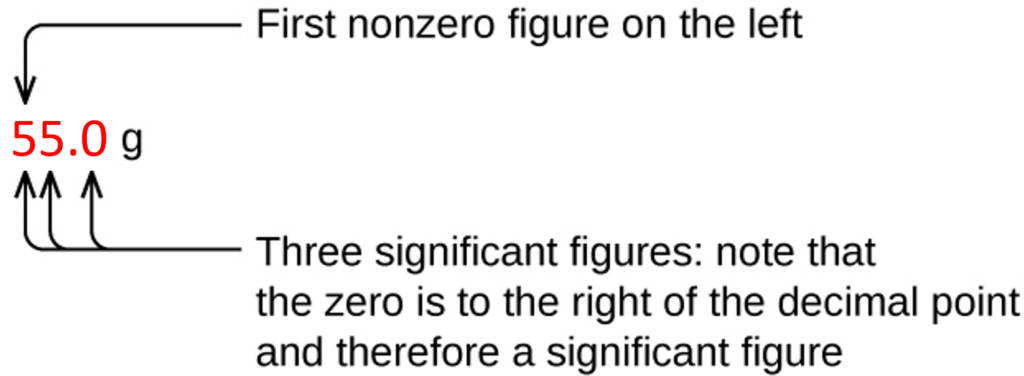A beekeeper reports that he has 525,341 bees. The last three figures of the number are obviously inaccurate, for during the time the keeper was counting the bees, some of them died and others hatched; this makes it quite difficult to determine the exact number of bees. It would have been more reasonable if the beekeeper had reported the number 525,000. In other words, the last three figures are not significant, except to set the position of the decimal point. Their exact values have no useful meaning in this situation. When reporting quantities, use only as many significant figures as the accuracy of the measurement warrants.
Significant figures (or significant digits) are one way to track the precision of our measurements, and help track the number of “real” measured digits in a reported value. Generally, when reporting measurements in the laboratory, we will write values such that the uncertain digit – that is, the first digit that is likely to change with a repeated measurement, which is the last significant digit – is the final reported digit. Unless otherwise indicated, it is assumed the uncertainty in the final digit of a measurement is ±1.
How Many Significant Figures?
When looking at a number, all nonzero digits are significant. Zeroes may or may not be “significant”, depending on their location in the number. To help identify zeroes as significant or not, we can label them as captive, trailing, and leading:

In this notation, captive zeroes – those that are found between other digits – will always be significant. Leading zeroes – those that appear to the left of the first non-zero digit – are never significant: they are simply placeholders so that the decimal point can be placed correctly. (Leading zeroes would always be dropped when converting to scientific notation.)

Trailing zeroes can be significant or not, depending on context. After a decimal place, as in 0.008020 in Figure 1 above, a trailing zero WILL be significant. Therefore, 0.008020 as written has four significant figures.

When there is no decimal place, the status of the trailing zero is ambiguous. To indicate if a trailing zero is significant, there are two conventions you can follow:
- Use the decimal point (.) to show the zero is significant. Following this convention, 100 has only 1 significant figure, while 100. would be read as three significant figures.
This method can be hard to follow, with an easily-missed decimal at the end of a value, but is nonetheless commonly used. - Avoid ambiguous trailing zeroes entirely by using scientific notation. $1.00\times 10^{2}$ clearly has three significant figures, and is distinct from $1\times 10^{2}$ which has only one significant figure.
When determining significant figures, be sure to pay attention to reported values and think about the measurement and significant figures in terms of what is reasonable or likely when evaluating whether the value makes sense. For example, the official 2016 census reported the resident population of Canada as 35,151,728. Do you think the Canadian population was correctly determined to the reported eight significant figures, that is, to the exact number of people? People are constantly being born, dying, or moving into or out of the country, and assumptions are made to account for the large number of people who are not actually counted. Because of these uncertainties, it might be more reasonable to expect that we know the population to within perhaps a hundred thousand or so, in which case the population should be reported as 3.52 × 107 people.
Exceptions: Logarithmic Values
Numbers that were the direct answer to a logarithmic calculation (e.g. pH, as calculated by $ pH = -log[H^{+}] $ ) are counted differently. The significant digits for a logarithm are only counted in the mantissa of the value – the part after the decimal. So the measurements of a solution with $[H^+]$ of 0.0111 and pH of 1.955 both have three significant figures as written here.
Exceptions: Exact Numbers
The exact numbers defined in the previous page are an exception here. Exact numbers (the counted or defined values) are considered to have infinite significant figures. This way, they will never be the value in a calculation with the fewest significant figures.